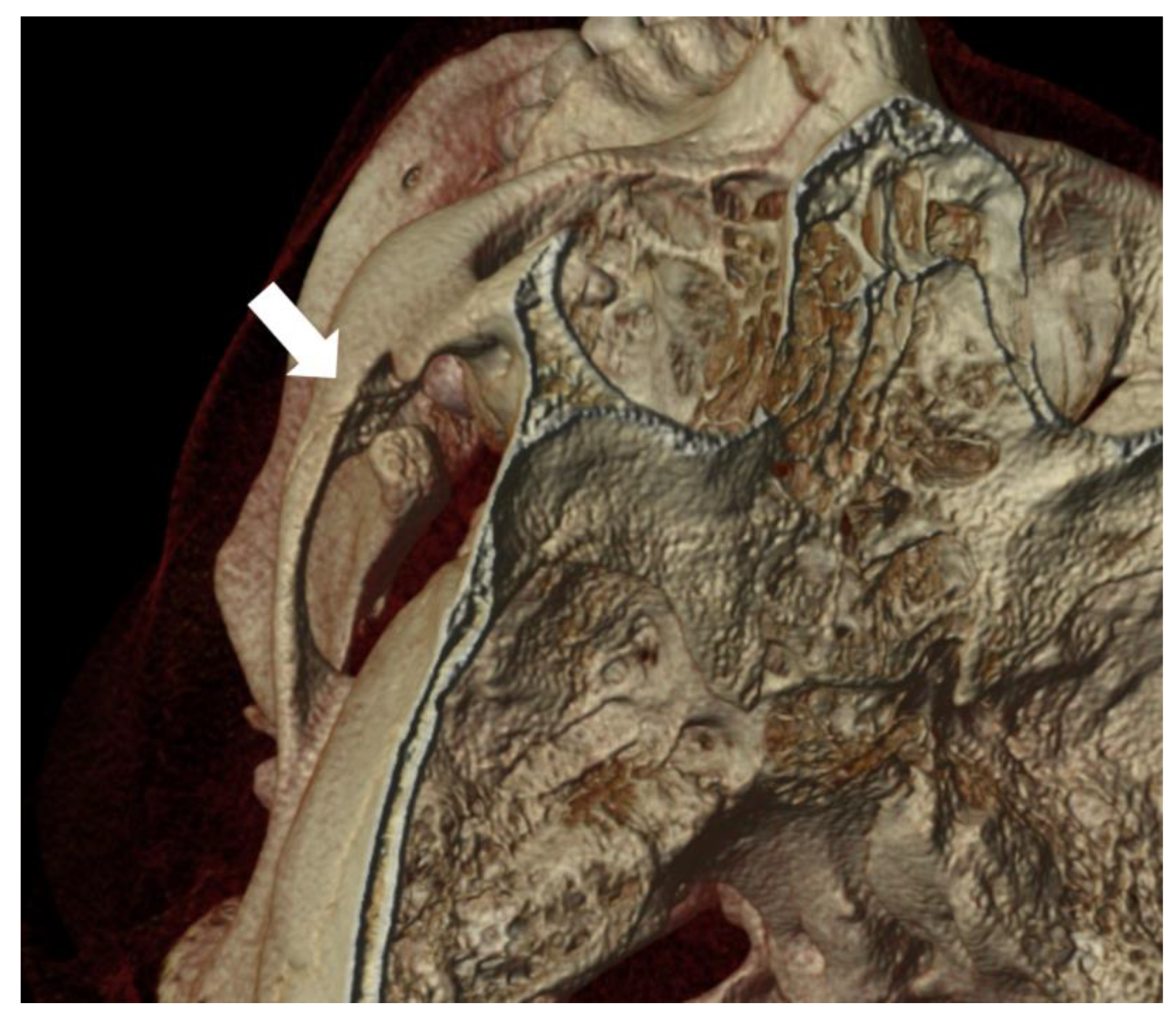Jacob Disease, Osteochondroma of the Coronoid Process, Coronoid Process Hyperplasia or Langenbeck Disease: The Big Jumble. Comment on Raccampo et al. Jacob’s Disease: Case Series, Extensive Literature Review and Classification Proposal. J. Clin. Med. 2023, 12, 938
- -
- Mandibular CPH, or Langenbeck disease, is characterized by an abnormally elongated coronoid process of the mandible, made of histologically normal bone tissue, responsible for impingement with the zygomatic bone [3].
- -
- Osteochondroma of the coronoid process is a benign bony neoplasm coated by normal cartilaginous tissue. Only the affected bone is covered by cartilage [4].
- -
Conflicts of Interest
References
- Raccampo, L.; Panozzo, G.; Tel, A.; Di Cosola, M.; Colapinto, G.; Trevisiol, L.; D’agostino, A.; Sembronio, S.; Robiony, M. Jacob’s Disease: Case Series, Extensive Literature Review and Classification Proposal. J. Clin. Med. 2023, 12, 938. [Google Scholar] [CrossRef] [PubMed]
- Jacob, O. Une cause rare de constriction permanente des machoires. Bull. Mém. Soc. Anat. Paris 1899, 1, 917–919. [Google Scholar]
- Mattei, L.; Raoul, G.; Barry, F.; Ferri, J.; Nicot, R. Is panoramic radiography adequate for diagnosing coronoid process hyperplasia? A case series. J. Stomatol. Oral Maxillofac. Surg. 2023, 101487. [Google Scholar] [CrossRef] [PubMed]
- Kerscher, A.; Piette, E.; Tideman, H.; Wu, P. Osteochondroma of the coronoid process of the mandible. Oral Surg. Oral Med. Oral Pathol. 1993, 75, 559–564. [Google Scholar] [CrossRef] [PubMed]
- Domart, M.; Nicot, R.; Mattei, L.; Cloître, A.; Lesclous, P.; Bertin, H.; Corre, P. Effectiveness of treatment by coronoidectomy and active rehabilitation in Langenbeck or Jacob diseases. A retrospective study of 20 cases. J. Stomatol. Oral Maxillofac. Surg. 2023, 124, 101351. [Google Scholar] [CrossRef] [PubMed]

Disclaimer/Publisher’s Note: The statements, opinions and data contained in all publications are solely those of the individual author(s) and contributor(s) and not of MDPI and/or the editor(s). MDPI and/or the editor(s) disclaim responsibility for any injury to people or property resulting from any ideas, methods, instructions or products referred to in the content. |
© 2023 by the authors. Licensee MDPI, Basel, Switzerland. This article is an open access article distributed under the terms and conditions of the Creative Commons Attribution (CC BY) license (https://creativecommons.org/licenses/by/4.0/).
Share and Cite
Mattei, L.; Raoul, G.; Schlund, M.; Nicot, R. Jacob Disease, Osteochondroma of the Coronoid Process, Coronoid Process Hyperplasia or Langenbeck Disease: The Big Jumble. Comment on Raccampo et al. Jacob’s Disease: Case Series, Extensive Literature Review and Classification Proposal. J. Clin. Med. 2023, 12, 938. J. Clin. Med. 2023, 12, 4966. https://doi.org/10.3390/jcm12154966
Mattei L, Raoul G, Schlund M, Nicot R. Jacob Disease, Osteochondroma of the Coronoid Process, Coronoid Process Hyperplasia or Langenbeck Disease: The Big Jumble. Comment on Raccampo et al. Jacob’s Disease: Case Series, Extensive Literature Review and Classification Proposal. J. Clin. Med. 2023, 12, 938. Journal of Clinical Medicine. 2023; 12(15):4966. https://doi.org/10.3390/jcm12154966
Chicago/Turabian StyleMattei, Léa, Gwénaël Raoul, Matthias Schlund, and Romain Nicot. 2023. "Jacob Disease, Osteochondroma of the Coronoid Process, Coronoid Process Hyperplasia or Langenbeck Disease: The Big Jumble. Comment on Raccampo et al. Jacob’s Disease: Case Series, Extensive Literature Review and Classification Proposal. J. Clin. Med. 2023, 12, 938" Journal of Clinical Medicine 12, no. 15: 4966. https://doi.org/10.3390/jcm12154966
APA StyleMattei, L., Raoul, G., Schlund, M., & Nicot, R. (2023). Jacob Disease, Osteochondroma of the Coronoid Process, Coronoid Process Hyperplasia or Langenbeck Disease: The Big Jumble. Comment on Raccampo et al. Jacob’s Disease: Case Series, Extensive Literature Review and Classification Proposal. J. Clin. Med. 2023, 12, 938. Journal of Clinical Medicine, 12(15), 4966. https://doi.org/10.3390/jcm12154966





